Eagles in the World Cup
Boston College was well-represented at the tournament.

Photographs by Astrid Riecken
Breaking the Oath Keepers
Prosecutors—and best friends—Lou Manzo ’06 and Brendan Downes ’07 are at the center of government efforts to take down the Oath Keepers extremist militia for its role in the January 6 insurrection.
Lou Manzo turned to face the jury. It was January 2023, and it had been two years since former President Donald Trump called his followers to Washington, DC, and pointed them at the US Capitol. Two years since the mob tried to violently prevent Congress from certifying Joe Biden’s victory in the 2020 election. Two years that Manzo ’06, MA ’07, had spent preparing for this moment. The thirty-seven-year-old federal prosecutor had drilled the closing argument he was about to deliver until midnight, then woken up before dawn to rehearse in the shower. As one of just five Department of Justice litigators tapped to take down the Oath Keepers, a far-right militia at the heart of the January 6 insurrection, he was part of an elite legal strike force, the best of the best at the DOJ. They hadn’t taken a day off in six months as they built their case. Now, after a five-week trial in a courthouse two blocks from where the extremists launched one the most brazen attacks on the American government in history, Manzo was ready to put an exclamation point on the government’s case against a group of men who’d helped fuel the whole thing. At stake was nothing less than the future of the republic.
“For over two hundred years, our country enjoyed the routine and peaceful transfer of power. It served as a core tradition in our democratic form of government,” he began, at ease in the spotlight, his slim-fitting light gray suit a sharp contrast to the standard-issue DC drab. “Over those two centuries, Americans saw many, numerous results that they disagreed with, were disillusioned or angry about. But each time power was transferred peacefully, because Americans respect the rule of law.”
He pointed at the four Oath Keepers in the courtroom: Roberto Minuta, David Moerschel, Joseph Hackett, and Edward Vallejo.
“Not these men.”
The Oath Keepers represented the ugly, serrated edge of America’s worsening political divide, a promise of authoritarian violence. The militia patrolled pro-Trump and far-right events. They handled security for felonious Trump advisors such as Roger Stone and Michael Flynn. They responded to the Black Lives Matter protests that erupted in the summer of 2020 after George Floyd’s murder by “guarding” businesses while toting semiautomatic rifles and glowering at protestors. And their leader, Stewart Rhodes, responded to the 2020 election by urging Trump to invoke the Insurrection Act, which Rhodes believed would give him legal cover to unleash his paramilitaries on demonstrators.
For the Oath Keepers at the center of Manzo’s closing argument, January 6 was an even better opportunity to impose their will on the country. Minuta, a New York tattoo shop owner, purchased 5,500 rounds of ammunition in advance of the attack. On the day of the insurrection, he led a team of Oath Keepers in a military “stack” formation to a designated spot outside the Capitol. Moerschel, a neurophysiologist from Florida, was part of another stack, a human battering ram deployed to breach the building. Once inside, he went hunting for Democratic leader Nancy Pelosi, whom some Oath Keepers wanted to execute. Hackett, a chiropractor and leader in the militia’s Florida chapter, did “unconventional warfare” training ahead of January 6 and drove up in a vehicle packed with guns. Vallejo, a US Army veteran from Arizona, helped to amass the arsenal the Oath Keepers stashed in a Northern Virginia hotel, beyond DC’s tight gun control laws. He participated in a heavily armed “Quick Reaction Force” that was on standby to deploy in support of the coup.
“A lot of what informs us is having lived in countries where democracy is very fragile,” Manzo said. “Everything can fall apart very quickly. And I don’t know if everyone in this country understands that.”
“Don’t get numb to this,” Manzo told the jury, aware that he was describing events so abnormal and disturbing that they could stupefy the average citizen’s faculties. A seasoned trial attorney with a background working violent crime and fraud, including a stint on an opioid task force that cracked down on pill mills in Appalachia, Manzo had seen a lot in his career, but January 6 astonished even him. As he explained the charges, he couldn’t help but think back to when he first started doing conspiracy cases—ones involving far more rudimentary wrongdoing. Back then, he’d tell jurors that while a “conspiracy” might sound like a grandiose plot in which people from around the country agree to do something awful, it didn’t have to be anything more complicated than two bad guys agreeing to steal a pair of shoes. Often, it wasn’t. But January 6 was a grandiose plot. It was a sprawling nationwide scheme to snuff out the American experiment itself. The Oath Keeper defendants had been charged with seditious conspiracy, a statute that deals with an agreement to use force against the government. The rarely used charge carries a high burden of proof, and the most notable previous seditious conspiracy conviction had come against Omar Abdel-Rahman, the “blind sheikh” behind the 1993 World Trade Center bombing. But just months earlier, Manzo and his colleagues had used the same statute to win a guilty verdict against Rhodes, the Oath Keepers leader, and one of his top assistants in a blockbuster trial that garnered international headlines and set the standard for January 6 accountability. (Three other Rhodes assistants were acquitted in that trial of seditious conspiracy but convicted of other charges.) Then, as in this second case, Manzo had to distill a staggering amount of evidence into a grim, inescapable truth.
“American democracy is fragile,” he told the jury, nearing the end of his presentation. “It cannot exist without the rule of law and respect for that rule of law. It will not survive if people who are dissatisfied with an election result use force and violence to try and change that outcome. That is what these defendants tried to do. They conspired to and then they did use force to halt the transfer of power. That is unacceptable. That is sedition. That is a crime.”
In the audience, Brendan Downes ’07 watched as Manzo, his best friend from Boston College, brought the government’s case to a decisive close. Downes, a federal litigator himself, had more than a casual interest in the Oath Keepers.
When Downes found Manzo a few minutes later outside the courtroom, he pulled “Louie” in for a hug. Downes, more than most, knew what can happen when domestic terrorists act out their violent fantasies. So did his mother, Debbie ’74, who’d also attended the closing. They were part of a small group of Boston College alumni and relatives who’d assembled in the hallway of the E. Barrett Prettyman Federal Courthouse. Manzo’s parents, Noreen and David ’77, were down from Boston. They’d held hands in court. Manzo’s aunt had come. So had his girlfriend, Britt. And his college roommate, Pete Boogaard ’07, and Alex Neckles ’07, another close friend. They all knew each other, a proud group there to celebrate one of their own as he performed a vital service to his country.
Soon, it would be Downes’s turn. Incredibly, he was also going after the Oath Keepers in court. As Manzo and the DOJ worked to put the militia members behind bars, Downes and his colleagues in the DC Attorney General’s Office were preparing to deliver the knockout blow—a civil case designed to bankrupt the organization.
Stewart Rhodes was unfit for combat. The Oath Keepers leader, fifty-five years old at the time of the insurrection, had an extra tire around his gut and a dwindling number of gray hairs on his head. His brief career in the US Army, in the 1980s, had been cut short by a training accident that injured his back, and the only menacing aspect of his mien—an eyepatch covering his hollow left socket—had a pitiable provenance: According to his ex-wife, Rhodes lost the eye after accidentally shooting himself in the face with a handgun. Despite his physical liabilities, however, he was considered to be one of the most dangerous extremists in the country.
Within days of the 2020 election, Rhodes began readying his militia for a “civil war” to prevent Joe Biden from taking office. In numerous private and public statements leading up to January 6, Rhodes told his Oath Keepers that they would have to march on the Capitol and start a “massively bloody revolution.” They would need to “rise up in insurrection.” He stocked up on weapons, ammunition, and night vision equipment, then made his way from his home in Texas to Washington. On the eve of the attack, he was filmed in an underground parking garage near the Capitol, scheming with other right-wing leaders, including Henry “Enrique” Tarrio, the head of the Proud Boys gang. The groups would spearhead the uprising.
On January 6, Rhodes entered the Capitol grounds around 2:12 p.m. and moved into position on the northeast side of the building. The area was familiar to him: He’d once worked for former Republican Congressman Ron Paul of Texas. Rhodes watched the attack unfold for a few minutes, then issued orders over his phone for the militia to move to the south side of the Capitol, where rioters had “taken ground” against the police line of defense. Even in the melee, his troops stood out, clad in military fatigues, tactical vests, and helmets, snaking through the mob in tight formation.
In his home a half mile away in the Capitol Hill neighborhood, Manzo watched in horror as the insurrection played out on his television. He’d sensed something terrible was coming. The city had been on edge the day before, crawling with angry Trump supporters. Still, the violent scenes at the Capitol were unimaginable, surreal. An earlier generation had experienced the same shock on 9/11. This time, however, the attackers were radicalized Americans, laying siege to the seat of democracy in their own nation. “All the shouting about revolution, and it was actually beginning to happen,” Manzo said. He was staring at an enormous crime scene. “I started thinking, What could I do?”
Manzo hurriedly messaged one of his mentors at the US Attorney’s Office for the District of Columbia, where he’d started his career in the DOJ. He volunteered to assist with any prosecutions that came out of January 6, and he had an ideal background to help. Because DC is not a state, most litigators in the US Attorney’s Office practice in Superior Court, essentially acting as local prosecutors. But Manzo had moved to “main Justice” after four years to do opioid cases and financial fraud prosecutions, giving him extensive trial time in federal court, which is where the January 6 cases were bound. He was also highly regarded in the USAO, both for the caliber of his work and his upbeat manner. Trials could be a slog. Manzo was fun to work with.
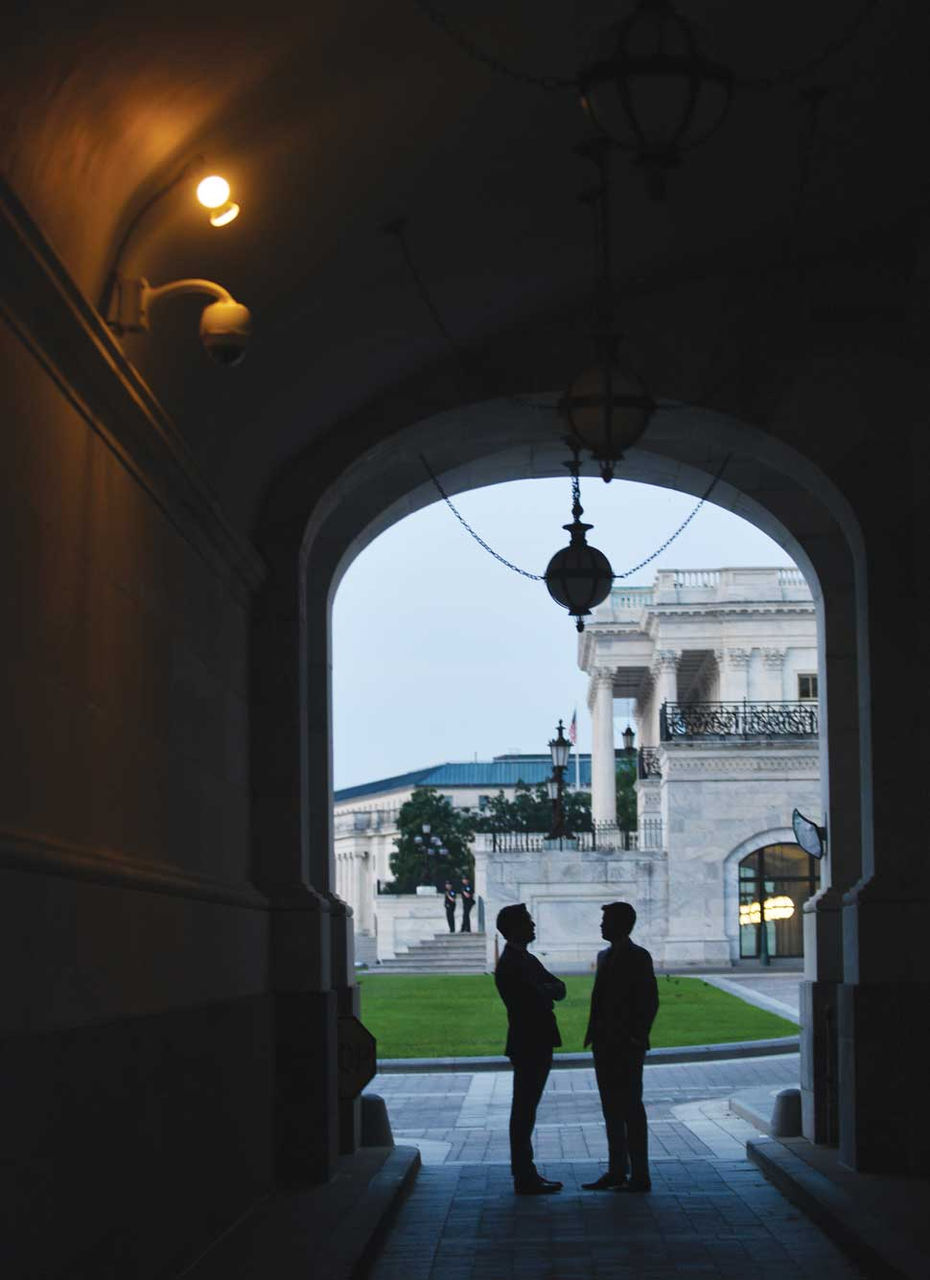
He got his first look at the Oath Keepers a day or two later, watching on video as militia members moved ominously up the east steps of the Capitol during the attack. “It just kind of struck me, like that’s the most terrifying thing,” Manzo recalled. “How did those people know to be together and move in formation and go up the steps? That doesn’t seem random.” He wanted to know who they were and what they were doing. He wanted that case. He fired off messages to more people in the US Attorney’s Office. Soon, he was on the team.
By March 2021, Manzo was helping his colleagues map out the scope of the conspiracy. They worked fast, with FBI agents cranking through evidence. Everyone knew about Rhodes. But who were the other individuals? As investigators gained access to phones and reviewed social media, they saw that the conspiracy was bigger than they’d originally thought. The DOJ had indicted several Oath Keepers within weeks of January 6 and kept going. One name led to two, then three, then more. Notably, Rhodes was not yet among them. Then, a year into the investigation, prosecutors added a stunning wrinkle: the seditious conspiracy count. Nobody had studied it in law school, but the Civil War–era statute offered a better prosecutorial option to charge the Oath Keeper organizers for what they had done: attempt to wage a war against the United States government. On January 12, 2022, Rhodes’s name was placed atop the new indictment.
Though Manzo couldn’t discuss the details of the prosecution, court documents and media reports reveal that he focused his attention on the Quick Reaction Force units that the Oath Keepers staged in Northern Virginia. The units were poised to enter the fray on January 6 and speed guns to the militia on Rhodes’s orders. One Oath Keeper even wrote about a plan to use a boat to ferry “heavy weapons” across the Potomac River.
After the seditious conspiracy indictments, US District Judge Amit Mehta split the case into two trials—the first involving Rhodes and four other top-level Oath Keepers, the second for the lieutenants. For months, Manzo and his colleagues would work all day, then hold a two-hour conference call at 10 p.m. after people had gone home to see their families. As trial dates neared, the hours increased. The lawyers worked every night, every weekend until 2 a.m.
The Rhodes trial began on October 3, 2022, and lasted nearly eight weeks. It was a spectacle. When Manzo cross-examined defense witnesses, he got them to acknowledge that they wanted to obstruct Congress and were willing to kill Americans. Rhodes, a Yale Law School graduate, took the stand and all but admitted to sedition. Manzo’s colleague, Kate Rakoczy, shredded the militia leader during cross-examination, deconstructing every piece of his defense in what Manzo calls the most impressive performance he’s ever seen in court. He knew he was watching history.
The most damning moment of the trial came when prosecutors played a surreptitiously recorded tape of Rhodes talking to associates four days after the insurrection. “We should have brought rifles,” he said. “We could have fixed it right then and there. I’d hang [expletive] Pelosi from the lamppost.” The courtroom went silent after that.
On November 29, 2022, the jury found Rhodes guilty of seditious conspiracy and other charges. In May, he was sentenced to eighteen years in prison, at the time the longest sentence for any January 6 participant. (In September, Tarrio, the Proud Boys leader, was sentenced to twenty-two years for seditious conspiracy.) “I never have said this to anyone I have sentenced,” Judge Mehta told Rhodes at sentencing. “You pose an ongoing threat and peril to our democracy and the fabric of this country.”
Manzo—and Downes—understood the danger all too well.
The first encounter between Lou Manzo and Brendan Downes was not an auspicious one. It happened their freshman year at BC in the McElroy dining hall, when Manzo sat down with a mutual friend at Downes’s table. Downes, a self-described introvert, didn’t know what to make of the boisterous Manzo, who was goofing around, commanding attention. “Laying it on thick,” Downes recalled. “I just remember thinking, ‘I don’t know about that dude.’”
His wariness would soon subside. Downes had grown up in Cambridge and attended Boston College High School, while Manzo was from Boston’s South End neighborhood and had gone to Roxbury Latin. Both came from families committed to helping their communities. Downes’s mother and father were Cambridge public school teachers. Manzo’s mother, a former nun, did affordable housing work for the homeless. His father, Dave, ran a special education program for high-risk youth and for four decades has been a beloved adjunct professor in BC’s acclaimed PULSE service learning program.
It was fitting, then, that their friendship blossomed over winter break in 2004 while on an Arrupe International service immersion trip to a migrant shelter in Tijuana, where they prepped meals, cleaned houses, and learned about immigration issues. Manzo suddenly made a different impression on Downes. One day, a Mexican migrant yelled out that he was going to cross the border, then walked out of the shelter. “I gotta go talk to that guy,” Manzo said, and rushed after the man. Downes watched through a window. “Lou just went and gave him a hug,” Downes recalled. “And I was like, ‘That’s a good human being. I should probably be friends with that guy.’”
After Tijuana, they hung out constantly. Downes took Dave Manzo’s PULSE program classes and would later become his teaching assistant in one of them. During his junior year, Downes decided to study abroad. Originally, he planned to go to Italy. Everyone wanted to visit. Then he switched to Kenya. “Not only does he go to Nairobi, but he goes and works in Kibera, which is the largest slum in Nairobi, might be the largest slum in all of Africa,” Dave Manzo said. “I’m like, Man, what kid does this? Brendan does this.”
What kid goes to visit him? Lou Manzo. He was the only one.
When Manzo arrived, Downes took him to Kibera, where Downes was tutoring children. As the lanky Americans strolled along, residents greeted Downes warmly. “They knew he was there for a good reason,” Manzo said. “If people respect you and trust you, you’re going to be safe. Just go for it. He was just going for it.”
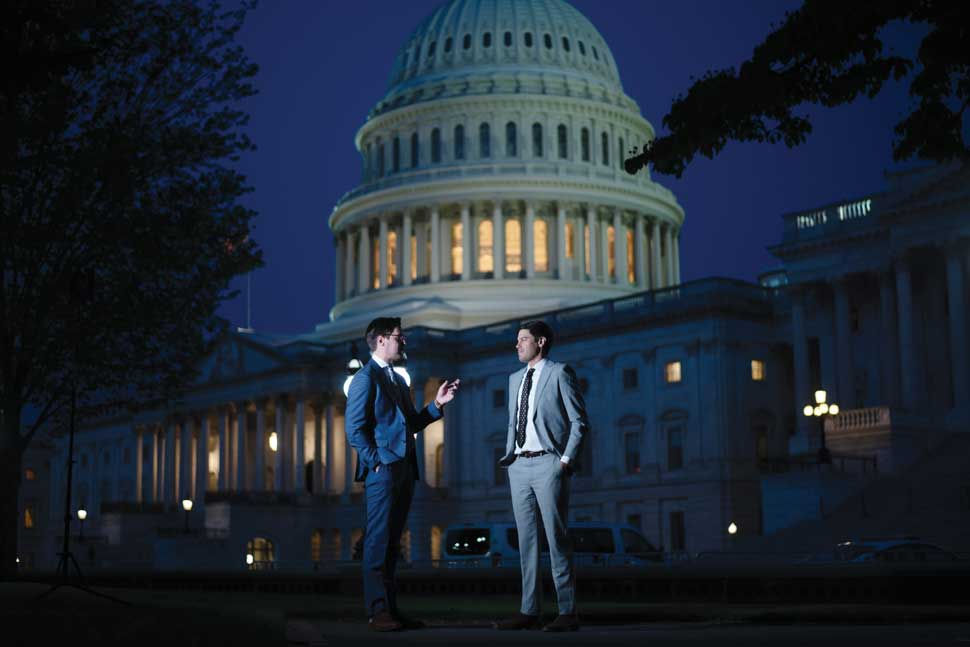
They later traveled through Kenya and East Africa together, into Uganda, the Democratic Republic of the Congo, and Rwanda, a journey seminal to both their friendship and their understanding of the world. In Rwanda, they visited a church where people were massacred during the 1994 genocide. The building was now a memorial to the dead. Inside, the victims’ bones and clothes were piled up where they’d been killed, a reminder and a warning of what can happen when the state breaks down and factional violence takes over. Afterward, Manzo and Downes, still contemplating the somber scene, crammed into a matatu, one of the shared and overcrowded minivan taxis that serve as public transportation in the region. They were cheek to jowl with about twenty Rwandans when Bob Marley’s “Redemption Song” came on. Downes turned to his friend. “Listen to this song,” he said. “Remember this moment. Be here.”
After graduating in 2007, they each returned to Africa for a year to work with humanitarian organizations. Manzo helped get a women-run, Black newspaper off the ground in Acornhoek, a township in northeast South Africa. Downes lived in a South Sudanese refugee camp in Nimule, coordinating with local leaders to improve the educational system in a place where kids sometimes attended classes perched atop crates of ammunition the military had stashed in schools. The work was taxing. They were lonely. Downes got malaria and worried constantly about his safety. “Is this too hard for you?” he wrote on the wall of his hut. It was intended as motivation but Downes also found himself wondering if he’d taken things too far.
Hardship in Africa, however, brought clarity. Manzo, who’d been considering a career in journalism, discovered he no longer wanted to just cover issues. He wanted to be part of the change. And Downes, who felt immense fulfillment during his year in South Sudan, which he calls the “most formative” of his life, realized he needed to seek out a career that offered similar satisfaction but more emotional balance. Law school beckoned.
“A lot of what informs us is having traveled and lived in a number of places around the world, especially in Africa, where democracy and peaceful governance is very fragile,” Manzo said. “America is the exception, not the rule. Everything can fall apart very quickly. And I don’t know if everyone in this country understands that.”
Downes and his colleagues are currently deep into litigating their case against the Oath Keepers, which also includes the Proud Boys. It’s the first civil case brought by a government entity against the militia and other January 6 insurrectionists. But it’s a long process and a trial might not start for many months. The objective is to make the extremist groups pay civilly, much in the way the Southern Poverty Law Center attorneys helped to effectively bankrupt powerful factions of the Ku Klux Klan and their members in the 1980s.
The case seeks to hold the “would-be insurgents” accountable for assaulting DC police officers who, rushing to defend Congress, engaged in hand-to-hand combat with insurrectionists for hours. At least sixty-five city cops were injured during the attack. One was electrocuted multiple times with a stun gun while rioters beat him unconscious. He was also beaten in the face with his own baton, which caused cranial injuries. Another officer was hit in the face with a metal pole, causing permanent injuries to his head and neck. The officer later killed himself.
“It’s easily forgotten that DC is a place a lot of local people call home, and we have our own police department, and they were on the front lines. That local perspective is often lost in the national discussion,” said Downes, who is thirty-eight, and before joining the DC Attorney General’s Office in 2020 spent six years working on voter discrimination cases for the Lawyers’ Committee for Civil Rights Under Law, where he mainly represented the NAACP.
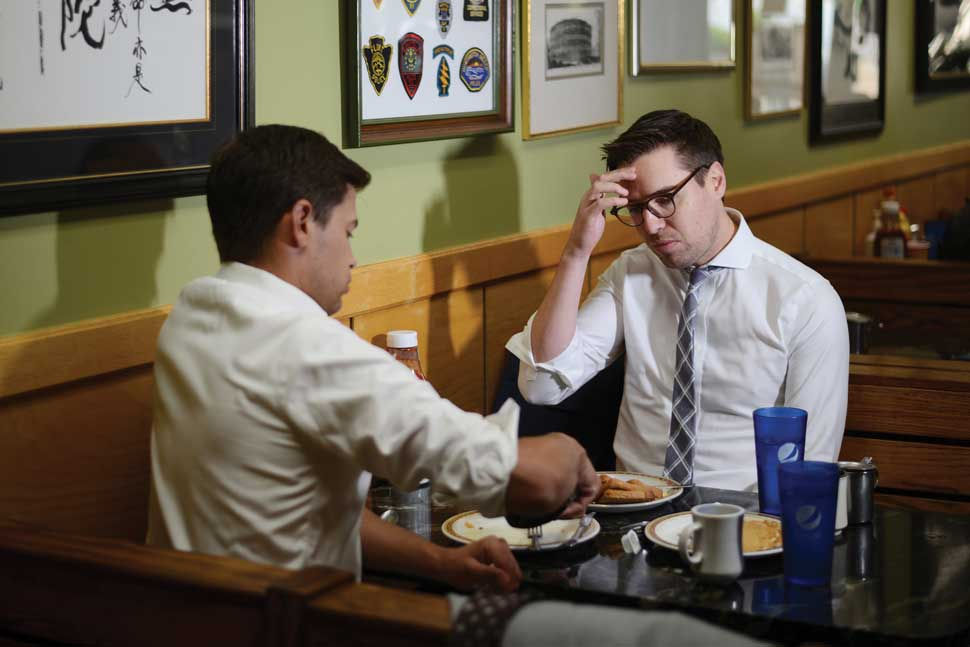
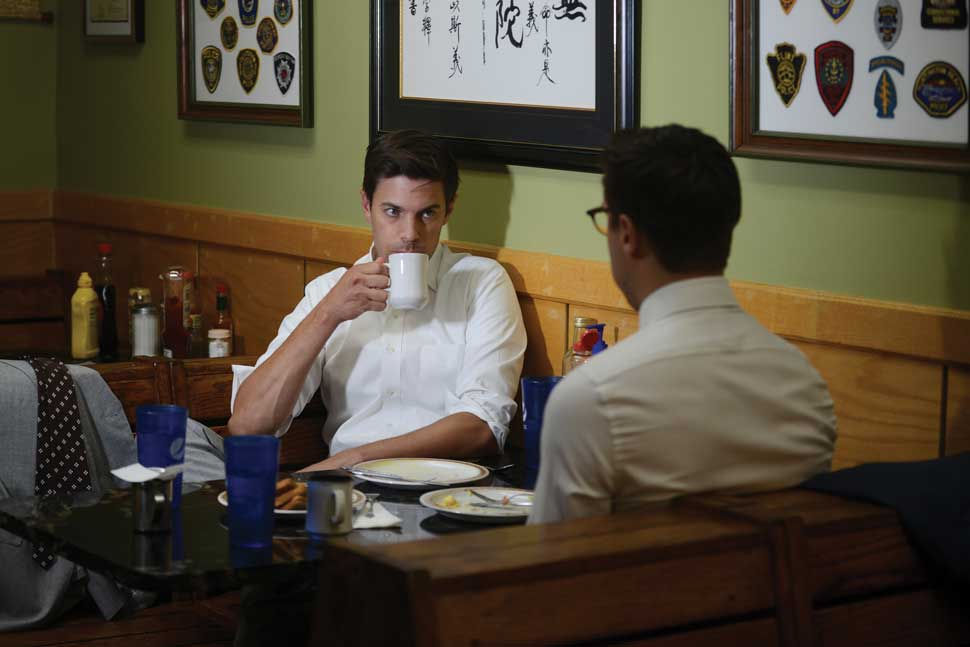
Like Manzo’s case against the Oath Keepers, Downes’s civil litigation, though complex, boils down to a simple truth stated plainly in court: January 6 was a “coordinated act of domestic terrorism.” On that subject, he has had ample personal experience.
Downes was in his second year of law school at American University when he heard the news about the terrorist attack on the Boston Marathon on April 15, 2013. Two bombs had gone off near the finish line a little before 3 p.m., as onlookers gathered to cheer on the runners. Three people were dead. Hundreds were injured, with many losing limbs.
Downes started making phone calls. His parents were on Cape Cod for Marathon Monday. They were safe. But his brother, Patrick, wasn’t picking up. Patrick Downes ’05 and his wife, Jessica Kensky, had run the marathon before. Cheering on others was something they’d do. Downes’s frantic calls kept going to voicemail. His parents couldn’t get through either. The only way Patrick wouldn’t answer was if he couldn’t. He must have been there.
Manzo at the time was a month away from graduation at Georgetown Law school, only a few miles from American. When he heard about the bombing, he called Downes, who by then had learned that Jessica was badly injured and in a hospital. There was still no word about Patrick, but a cousin had found a picture online of him being taken away in a wheelchair, a distraught look on his face, a blanket covering his lower body. Manzo rushed over from Georgetown. He had a gray 2005 Honda Civic, and when he pulled up, he found Downes in a daze, unsure what to do. Was his brother even alive? “Get in the car,” Manzo said, piling his friend into the passenger seat. “You need to be in Boston. Let’s go right now.”
They spoke sparingly as they drove north on I-95, an eight-hour ride, the sun dipping below the horizon. The attack was personal for Manzo too. Boston was his hometown. The bombs had detonated ten blocks from his parents’ house. As they passed Manhattan in the night, they saw the new One World Trade Center illuminated, nearly complete, a towering reminder of the pain that terrorists had visited on New York and Washington in 2001. Downes’s father called. “Brace yourself,” he said. Patrick was in surgery at Beth Israel. He’d lost his left leg.
They reached Boston around 2 a.m. Manzo dropped Downes off at the hospital, waiting for him to get inside. Patrick was partially sedated in the ICU. He was going to survive. He’d later hear about what Manzo had done for Downes, and for him. “That drive really forged their friendship and certainly forever indebted me to Lou,” Patrick said. “It’s like one of those blood brother moments.”
“It’s every parent’s dream that their child has the support of great friends,” Dave Manzo said. “On the toughest night of Brendan’s life, Lou was there for him. And I know that if the roles had been reversed, Brendan would be there for Lou. There’s no doubt in my mind.”
Following Manzo’s closing remarks in the second Oath Keepers trial, the jury deliberated for three days before making a decision. As the foreperson read the verdict in January, Roberto Minuta, David Moerschel, Joseph Hackett, and Edward Vallejo stood impassively in court. The extremists, having traded tactical gear for coats and ties, were found guilty, all of them, of seditious conspiracy. They were also convicted of two other conspiracy charges, and of obstructing an official proceeding—which is to say stopping Congress from certifying the 2020 election. Mehta would eventually give them light prison sentences, ranging from two to four and a half years—less than a third of what Manzo and his colleagues recommended—but for the DOJ, the outcome was a triumph. US Attorney General Merrick Garland credited prosecutors for their “excellent work on this case.”
A few months later, Manzo and Downes met up at a pizza restaurant in northeast DC. Manzo drank a Manhattan. Downes sipped a beer. They reminisced about the ice fishing trips they used to take to Quebec, and also about another tradition they created, still going, called the Creekside Cup. It’s an absurdist annual golf tournament they play with other Boston College friends, and its rules have evolved over time into a comically impenetrable thicket of ordinances. “At first I tried to understand it and then I realized the whole point is not to understand it,” Patrick said.
Over pizza, the friends discussed their work. Their jobs had never been mere jobs. They were vehicles by which Manzo and Downes, like their parents, could do good in the world. “The Jesuit calling of being men and women for others resonated with them,” Downes’s mother Debbie explained. While it’s true that prosecutors seek to punish, what often goes unmentioned is what they stand in defense of. For Manzo and Downes, it had always been the marginalized, the poor, the people treated unfairly by life. They were actually living that calling.
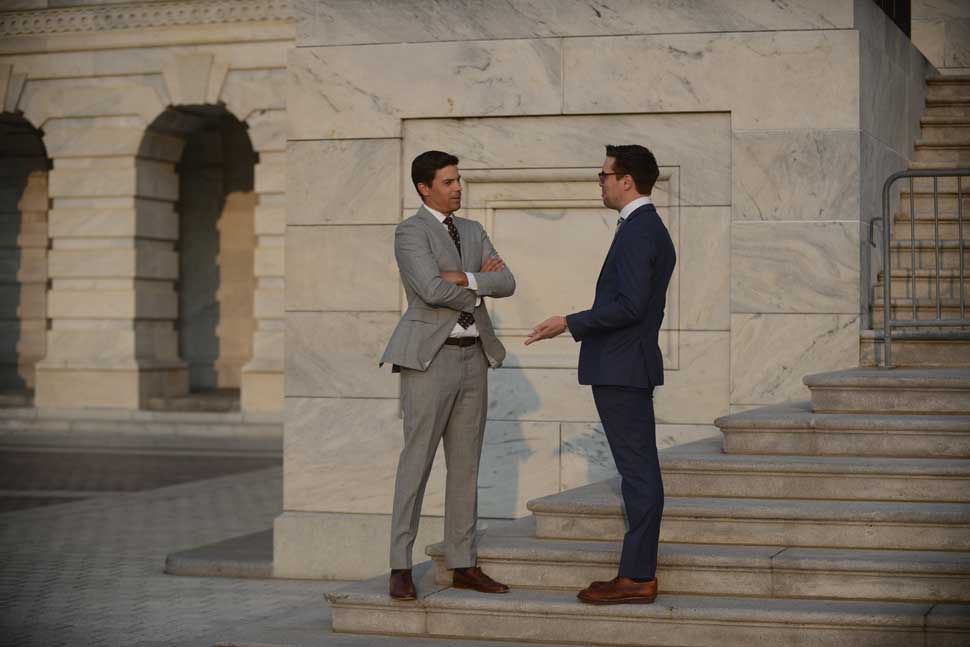
Just in May, for instance, Downes had won a major ruling against a slumlord who owns the Marbury Plaza apartment complex in southeast DC. Downes primarily did housing cases for the DC Attorney General’s Office, using the court system to recoup money for residents forced to live in substandard conditions. He loved the work, which was “squarely about doing good” and had a clear racial justice angle in a historically segregated city. In the Marbury Plaza case, tenants were living with leaks, mold, malfunctioning elevators, rodents, and inadequate security. At the height of summer, the air conditioning broke. People slept on balconies for weeks to escape the heat. When the owner failed to fix up the buildings as agreed, Downes convinced a judge to award the tenants retroactive rent credits worth around $5 million. It was one of the largest awards the DC Attorney General’s office had ever gotten for a housing-conditions case.
“Good job, Downsie,” Manzo said in the pizza restaurant.
Their conversation returned to January 6. Back to Americans traveling hundreds, if not thousands, of miles to Washington, armed, talking about fighting a civil war over the results of a fairly contested election. They both agreed that it was a “miracle” the coup attempt ended how it did. And it wasn’t over. Millions of Trump’s supporters still refuse to accept that he lost, with some inclined toward violence. The January 6 prosecutions might deter them from coming to Washington, but Manzo and Downes held little hope that the guilty verdicts would change minds so warped by lies.
“Democracy is incredibly fragile,” Manzo said. “When I’d be on the road talking to people, you still see how very fragile it is. I would say even beyond the word fragile. Perilous.”
As they finished their pizza, a short walk away from the Capitol, they tried to place a quote they’d paraphrased, something about America being the last greatest hope. The quote was from Abraham Lincoln, from a speech he gave to Congress one month before signing the Emancipation Proclamation: “We shall nobly save, or meanly lose, the last best hope of earth.” But there was more to the speech, and another part of it felt equally apt to describe both the critical work Manzo and Downes were doing for their country and the lives they’d chosen to lead.
“Fellow-citizens, we cannot escape history,” Lincoln said. “We … will be remembered in spite of ourselves. No personal significance, or insignificance, can spare one or another of us. The fiery trial through which we pass, will light us down, in honor or dishonor, to the latest generation.” 
Luke O’Brien is a writer based in Washington who has covered political extremism since 2016. His work has appeared in The Atlantic, Fortune, Rolling Stone, ESPN, Fast Company, and many other publications.